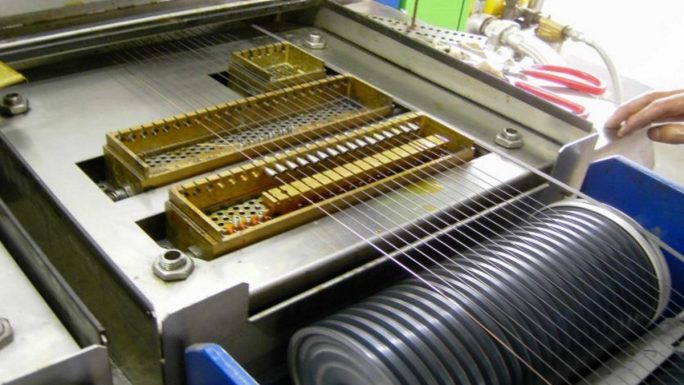What Are Wire Enamels?
Wire enamels are applied on copper and aluminum round and flat wires used in motors, transformers, generators and electrical measuring instruments. They are cured onto the wires with heat. The resulting coating’s main function is electrical insulation. Wire enamels are also described as primary insulation. The coated wires are sometimes called “magnet wires”.
Wires insulated by wire enamels
Wire enamels are applied to copper and aluminum wires in up to 30 layers. This provides electrical insulation and helps the windings from short-circuiting. These wire enamels must also have very good chemical and thermal resistance, must adhere very well to copper or aluminum wire, and have outstanding mechanical stability.
In some instances, for example when used in inverter-driven electric motors, the appropriate insulation layer should resist possible partial discharges, which can cause the motor to short-circuit and fail.
The wires that are coated vary greatly depending on their use. Some may be smaller than the diameter of a single human hair – in electronic components of watches for instance. But in heavy electric motors in wind generators, the diameter of round or flat wires can measure up to several millimeters.
The wire enamel is applied differently depending on the shape and diameter of the wire to be coated. Horizontal or vertical application, or application with dies or with felts, are typical wire coating methods.
Thanks to Axalta’s close relationship with the international magnet wire industry, the company is able to develop new technologies and manufacturing processes continually, as well as adapt its product portfolio to meet the ever-changing market requirements. This also means that Axalta has created custom wire enamel solutions in particular for motor applications that have helped to improve and to optimize specific customers’ operational performances.
Chemically, the wire enamel range consists of polyurethane, polyester, polyesterimide, polyamide-imide. The range of solids content starts at nearly 8% and ends at 60% (1g/1h/180°C), and the viscosity range is between 30 and 60000 mPas (23°C).
Polyurethane Wire Enamels (PUR)
Wires insulated with polyurethane enamels have good solderability at 375°C, and there are special formulations that provide excellent crazing and pin-hole resistance. These wire enamels are mainly used in small transformers, timers, relays, small motors, solenoids, clock coils, watch coils, fly-back transformers and magnetic heads.
Solderable Polyesterimide Wire Enamels (PEI)
Solderable polyesterimide wire enamels are widely used on magnet wires for relays, small transformers, small motors, contactors, ignition coils, magnetic coils and automotive coils.
The Voltatex 7200 series, one of Axalta’s polyesterimide wire enamels, allows solderability at temperatures above 450°C. These coatings are particularly well-suited in small electrical motors to connect the windings to the collector. The coated magnet wires have good elasticity as well as good dielectric and mechanical properties.
THEIC-Modified Polyester Wire Enamels (TPE)
THEIC-modified polyester wire enamels are used as a basecoat on aluminum and copper wires and offer very good mechanical, electrical, chemical and thermal resistance.
THEIC-Polyesterimide Wire Enamels (TPEI)
THEIC-polyesterimide wire enamels, which are highly heat-resistant, offer very good mechanical, electrical and chemical resistance. These wire enamels are widely used on wires in electrical motors, refrigeration equipment, transformer windings and ballasts for fluorescent lamps.
Thanks to its very good mechanical properties, a high thermal rating and good chemical resistance, Voltatex 7300 AX is used to coat wires widely used in smaller transformers, cooling aggregates and electrical ballasts.
How to protect against corona discharges?
Corona discharges can occur in high voltage applications of electrical devices, such as inverter fed motors, transformers, high voltage rectifiers, generators, ignition coils, wind generators, hybrid motors, elevators or pump motors. The Voltron® system, whose technology has been granted a worldwide patent, comprises a basecoat and a topcoat – the Voltatex 7700 and Voltatex 8500 series. Voltron can only be used under certain conditions. Please contact us for detailed information.
Polyamide-imide Wire Enamels (PAI)
Polyamide-imide wire enamels can be used either as dual or single coat, but both options deliver excellent mechanical properties and chemical resistance. In addition to the classical polyamide-imide overcoat, Axalta provides a wire enamel with integrated lubricants for increased winding speed. These products are specifically used to coat wires in electrical motors, refrigeration equipment, transformer windings and ballasts for fluorescent lamps. For flat wire applications, big transformers and generators, Voltatex 8300 series, based on polyamide-imide, is recommended. It can be used as a flexible top coat in combination with a polyester or polyesterimide base coat to improve the mechanical, chemical and thermal properties of the coating. In certain circumstances, Voltatex 8300 series can also be applied as a single coat for flat wire applications.
Polyvinylformal Wire Enamels (PVF)
Polyvinylformal wire enamels are suitable for heavy round and rectangular conductors. They provide excellent mechanical stability, superb adherence to copper, and resistance to transformer oil. These highly sophisticated enamels are mainly used in large generators and transformers due to their excellent mechanical properties. In addition to the good dielectric properties, these enamels also show outstanding chemical resistance, which makes the coated wire suitable for use in hermetic applications and in oil filled transformers according to IEC60 851-4. They are also well-suited for the production of flat wires for transposed cables (CTC).
Self-bonding Wire Enamels (SB)
Self-bonding wire enamels that are based on epoxy, polyvinyl-butyral and polyamide are used to stabilize the winding. They are mainly used to coat instrument coils, voice coils, loudspeakers, small motors and sensors.



